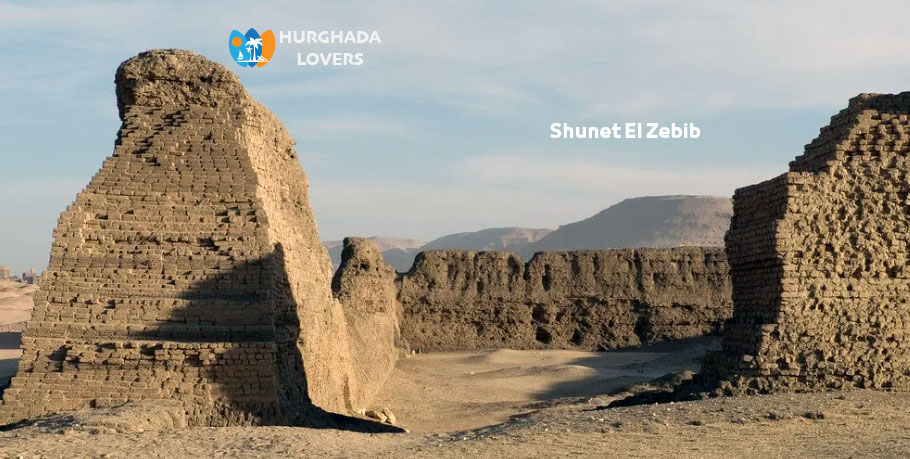Shunet El Zebib in Abydos, Sohag, Egypt | Facts, History Pharaonic Archaeological Sites, Map, Entrance Fees, Opening Hours and more…
Facts and history of the most important Pharaonic archaeological sites in Abydos and Kom Sultan, how much is the entrance ticket, working hours and more.
The archaeological area of Shona al-Zebib, which is actually a large structure made of mud bricks, was located in the archaeological area of Abydos located in Upper Egypt, specifically in Sohag Governorate.
The history of this huge and large edifice dates back to the era of the second Egyptian dynasty, from about 2700 BC, and it was built by the Egyptian Pharaonic King Khasekhemwy.
Hurghada lovers Offer Luxury Hurghada to Luxor Tours | El Gouna to Luxor Tours | Makadi bay to Luxor Tours | Sahl Hasheesh to Luxor Tours | Soma bay to Luxor Tours.
Shunet El Zebib
Where is the Shunet El Zebib area?
● In fact, the archaeological area of Shuna al-Zebib is located to the west of the area known as Kom al-Sultan, and it was to the northwest of the temple of King Ramses II.
● It rises approximately at a distance of approximately 2 km, and it was united and occupied around it by another large group of the most important groove of ancient and huge funerary buildings or walls that were rectangular in shape.
● The outer walls of the archaeological area also appear in the form of a palace facade, as it was dating back to that period from the beginning of the dynasties.
● However, only that building that belongs to the archaeological king Khasekhemwy, one of the kings in the era of the Second Dynasty, which is now known by the same name, which is Shona al-Zabib, remains of those buildings until now.
The reason for naming the archaeological area of Shouna Al-Zabeeb by this name
● During the Coptic era, the name Shonat Elzebib was given because it had been used as a wine press.
● For those in the late period, they were used as burials for the Apis bird, and then they were actually used as a house for guarding the felonies.
● It is an area that has a very great and great archaeological and historical importance, as it was already built by that ancient king Khasekhemwy, one of the kings in the era of the Second Dynasty.
● It is considered the first and most important huge building in this way. It was built of mud bricks. His idea was then inspired by King Djoser, the king, founder of the Third Dynasty, and he designed the hierarchical group named after him in the Saqqara region.
What is the description and design of the raisin bar?
● The antique window of the raisins, made of reinforced mud brick, consists in its design of two rectangular walls surrounded by an outside.
● They are also intertwined with each other like a shoe box.
● The size of one outer wall of this rectangular box is about 137 x 77 m, which is about 5 m and also 12 m high.
● The facade of that outer wall in Shunat al-Zabib was also carved, as it was designed to mimic the facade of that royal palace.
● The fence also provided two entrances, one of which was located in the eastern corner, and the other was the tourists located in the northern corner.
● As all those entrances were once one of the days consisting of a number of huge doors that were made of stone, and a number of materials used to make wings for that door, but they are not known until now.
Raisin Shona from the inside
● This inner area of the Raisin Shouneh consists of a large but largely empty square; But it is not completely known whether there were a number of these basic structures or those large buildings that were present in them, such as what is known as the mausoleum or temple.
● Whereas in 1988, the Australian Egyptologist and archaeologist David O’Connor discovered a square or flat courtyard that was made of a group of archaeological rubble consisting of fine limestone, and it was covered with mud bricks and it was formed by the number of four Roughly degrees and flat shape.
● But the only religious building that can be proven archaeologically in that place is a small church that was located close to that southeast corner of the place.
History
The barn was built in that area to be the so-called funerary enclosure, which is the place where the deceased king was worshiped in the past and then preserved.
The Egyptians had also called that archaeological place “Beit El Ka”, as it was considered a kind of that great precedent to the funerary temples that were known under the era of that ancient Egyptian kingdom.
What is the price of a visit ticket for the Egyptians?
● The fee for an adult visitor ticket is 10 EGP
● As for the fees for a visit ticket for Egyptian students, it is: 5 Egyptian pounds
What is the price of a visit ticket for foreigners?
● The fee for a visitor ticket to Shona El Zebib is 40 Egyptian pounds
● If the visitor is a foreign student, the entrance fee is 20 Egyptian pounds
